Are you looking for the perfect Costa Rica 3 week itinerary? We have exactly what you need. After our 111-day trip through Central America started with a road trip through the most remote corners of Argentina and Chile, our next destination was Costa Rica. The contrast between those countries could not have been bigger. We went from steadily over 2500-4000 meters of altitude to sea level, from the dust-dry desert in the humid, tropical jungle and from South to Central America. We spent almost a month in the Central American country. During our road trip in Costa Rica we visited the relaxed Caribbean coast, the rainforests, the surfer beaches on the Pacific coast, volcanoes and numerous national parks.
How Long To Stay In Costa Rica?
Costa Rica has a hell lot of things to do and beautiful places to visit. Of course we only saw a small part of it on our road trip. We summarized our 3 week itinerary through Costa Rica as well as our experiences, tips and must sees for a round trip through the humid green country in Latin America for you.
Our Costa Rica 3 week itinerary included the following locations and regions:
- San Jose
- Corcovado National Park
- Dominical
- Samara
- Tamarindo
- Monteverde
- Fortuna
- Tortuguero
- Puerto Viejo
- Bocas del Toro (Panama)
Costa Rica Itinerary for 1-2 Weeks
If you only have 1 or 2 weeks, you can still follow our route and just skip a few stops. We would recommend you to skip the Nicoya Peninsula with Samara and Tamarindo. The Nicoya Peninsula is very beautiful and full of rough nature, but unfortunately also difficult to travel since the roads are not in a good condition.
In addition, you could skip the northeast of Costa Rica, with Puerto Viejo and the trip to Panama (Bocas del Toro). Because although it is also beautiful there, the distances from the other stops (San Jose or Tortuguero) should not be underestimated. And so you could save a few days to a week.
Our Must Do’s for a Costa Rica Itinerary are:
- Corcovado / Bolita Rainforest Hostel
- Monteverde
- Fortuna
- Tortuguero
So, looking for a shorter itinerary? Read our 7 days to 2 week itinerary for Costa Rica.
You can find our complete Costa Rica itinerary on Google Maps:
The Difference Between the Pacific Coast and the Caribbean Coast
Before we started our Costa Rica 3 week itinerary, we were concerned that Costa Rica could be too western. And that’s partly true. When we arrived in San Jose we were shocked by the numerous fast food stores (Taco Bell, McDonalds etc.) and the generally very american style of streets, buildings and shops. Ok, we generally don’t like big cities as much as nature, but San Jose is a very characteristic example in terms of noise, stench and traffic. In the south and on the Pacific coast, Costa Rica is in general more western and maybe more tourist-oriented.
Quite the opposite of the Caribbean coast in the north of Costa Rica. There you can feel the Caribbean influence with dreadlocks, some dope and an everywhere serenity. At places like Tortuguero, Puerto Viejo or Cahuita, the lifestyle and the atmosphere is totally different than the southern places Dominical or Tamarindo. Everything here is casual, relaxed, easy. Nobody is in a hurry.
You can feel the Pura Vida all over Costa Rica, but in our opinion this is the lifestyle especially on the Caribbean coast. This is also the reason why we liked the Caribbean coast in Costa Rica much more than the Pacific coast.
Day 1: San José
For our Costa Rica 3 week itinerary we arrived in Costa Rica on San Jose’s huge airport. San José is located pretty much in the middle of Costa Rica and was therefore a good starting point for us to head to the different destinations of our road trip. At that time we did not know that we would not be in San José just for once, as planned.
San José itself is a huge city that has not that much to offer (Addendum: This impression has also changed positively from visit to visit). Since we had planned to travel to the jungle on the second day, we used our stay in San José to replenish our supplies and buy all the necessary food.
Tips for Grocery Shopping in Costa Rica:
- Cheap supermarkets: Pali oder Maxipali
- More expensive but with good salads: AM/PM
Day 2-5: Bolita Rainforest Hostel
In order to recover a little from the efforts of the past weeks, we selected the Bolita Rainforest Hostel as the first destination on our Costa Rica itinerary. We wanted to relax and go hiking in the middle of the jungle for a few days away from civilization. The Bolita Rainforest Hostel was exactly the right spot for this and at the same time a cheap alternative to the Corcovado National Park. You can find all information in our post about our jungle adventure.
Read our Corcovado blog post: ★ Corcovado National Park on a budget ★
The Corcovado National Park is clearly one of the most beautiful national parks in Costa Rica. However, we were deterred by the horrendous prices of about 100 Euro per person per day. That’s about how much the entrance fee plus (obligatory) guide costs per person. But we did not want to spend this money. After our experiences in the jungle of Sumatra we knew that it is much cooler to walk alone through the jungle. So after some research we found the Bolita.
If you prefer a guided tour through the Corcovado National Park you can book it at Get Your Guide*. The advantage of a guide is that you will not miss any animal and the guides usually have good telescopes and can tell you a lot of interesting facts about flora and fauna.
Adventurous Tour at Corcovado | Check Prices*
Check out the Bolita Rainforest Hostel*, where we spent 4 nights. It is by no means a 5-star hostel or offers a lot of privacy (which is also difficult without walls), but the unique atmosphere and the unobstructed view from every room of the lush green jungle in front of you, is worth every mosquito bite and every interrupted night by howler monkeys. We felt very comfortable and just saw a lot of nature and animals on the hikes.
Definitely one of the coolest hostels we have ever been to.
Bolita Rainforest Hostel on Booking.com*
Day 6: How To Get To Dominical
After our wonderful stay in the jungle we went back to civilization and further to Dominical on the Pacific coast of Costa Rica. Even though Costa Rica has a well-developed bus network, we have noticed how complex and actually costly the journey by bus is. This gave us first thoughts about booking a rental car for the further road trip through Costa Rica.
But we still had a long bus trip ahead of us before we could switch to a rental car. We drove about 170 kilometers from our jungle paradise close to the Corcovado National Park. We actually wanted to go to Uvita first to see the beach shaped like a whale fin. But since our host at the Bolita Hostel told us that the city of Uvita is actually not very suitable for overnight stays and Dominical would be much nicer, we decided to drive a few kilometers further.
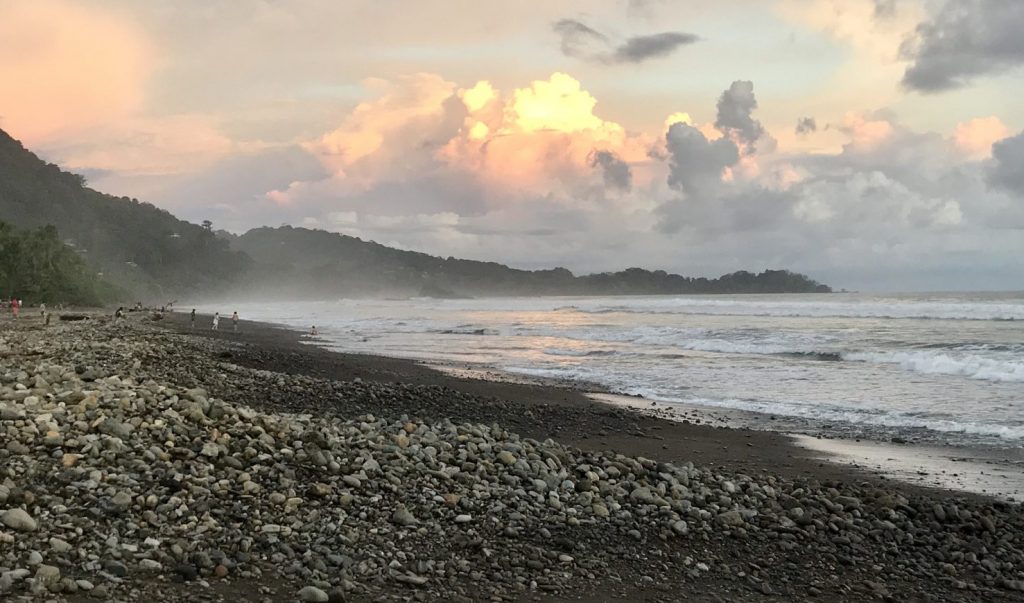
How to get to Dominical from Don Brazos (close to Corcovado NP):
- A taxi took us to the bus terminal in Puerto Jimenez at 8 a.m. in about 30 minutes. Cost: 13,000 colones (approx. 20 Euro)
- The bus took us from Puerto Jimenez at 9 a.m. to Palma Norte in about 2.5 hours. Cost: 4,030 colones (approx. 6 Euro)
- From the bus stop in Palma Norte we had to walk approx. 300 m to the next bus station and take the bus to Dominical at 12.45 p.m. The trip took about 1.5 hours and cost 2,200 Colon pp (about 3.50 Euro).
Why To Book a Rental Car on a Costa Rica 3 Week Itinerary?
In the end, the journey from Corcovado to Dominical took us almost 7 hours and cost a total of 39 Euro. In addition, there are the costs for the onward journey from the bus station to the hotel, the national park or wherever you want to go. Since our next destinations were further apart and we wanted to be more flexible, the rental car prices were researched without further ado. You can get a rental car with a good insurance package for around 30 Euro a day.
We didn’t had to think about it and rented a small Suzuki SUV with four-wheel drive for the next days. In Dominical and most of the other tourist locations in Costa Rica itinerary there are Alamo stations where you can pick up your car.
Relax in the evening
After that was done, we spent the rest of the evening on the surfing beach and researched our next destinations. Dominical city actually only consists of a long main street with many shops, tour providers and hotels. The mood here is pretty chilled, the proximity to the beach (by the way with a damn great sunset) creates a great atmosphere here and you can endure it well.
Dominical is close to some sights, such as the Manuel Antonio National Park or the Rainmaker Forest, which makes it a good starting point for further tours. Especially surfers get their money’s worth here and this place is made for them.
Hotel Recommendation in Dominical
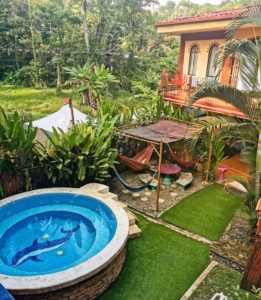 We spent the night in the highly recommended Cool Vibes Hostel* within walking distance of the beach. A real surfer hotel with the right clientele and a cool and relaxed vibe.
We spent the night in the highly recommended Cool Vibes Hostel* within walking distance of the beach. A real surfer hotel with the right clientele and a cool and relaxed vibe.
- big common kitchen
- only a few meters to the beach
- very relaxed atmosphere
Day 7: Rainmaker Forest
Our road trip with a rental car finally started on the seventh day of our Costa Rica 3 week itinerary (although we had been on the road in the bus so far). We took over our small SUV and actually wanted to go to the Manuel Antonio National Park. Actually, since we had to find out shortly before arrival that the park is closed on Mondays … and now guess which day we it was 🙁
So we quickly looked at what other options we could have nearby. Before our trip, I had already researched some information about Rainmaker Forest, a small privately run park, so we headed for it as a spontaneous day trip destination.
How To Get To Rainmaker Forest
The Rainmaker Forest is about 30 km from the Manuel Antonio National Park. The reviews keep reading that the Rainmaker is a good alternative to Manuel Antonio. However, we absolutely cannot agree to this because the two parks are completely different. We are therefore glad to have visited both, even if the entrance fees are very expensive. The Rainmaker Forest costs $ 20 entry per person, the parking lot can be used for free. The approach leads from the main road about 7 kilometers on a very bumpy road that can be driven almost only at walking pace especially close to the entrance.
From the entrance of the Rainmaker Forest, take a short path on the left until you are suddenly enveloped in the dark canopy of the rainforest. Shortly after the entrance we made the first great discovery. A small black and green coloured frog hopped past the edge of the path and became our animal picture of the day.

Hiking through the Rainmaker Forest
From here the path continued to a fork in the path. We had to decide whether we wanted to admire the wet green jungle from the ground, along the river, or walk over the hanging bridges anchored in the canopy of the trees.
We decided to do the river hike first. The path led continuously past the rushing river. There are four places to bathe in the clear, cold water of the river. However, the slow onset of rain during our visit ensured that we decided against cooling off. With every step the raindrops pattered down on us and the smacking sound of our hiking boots on the ground increased. In order not to get completely soaking wet, we looked for protection under a few large leaves and took a short lunch break.
The Suspension Bridges
After the lunch break we followed the path to the end of the river. At the end of the hike along the river, we had to climb steeply … and not without reason. The rest of the way led over shaky, narrow suspension bridges through the treetops lined with green leaves. In fact, the suspension bridges don’t look particularly trustworthy. The wooden planks are soaked and rotten and there are always holes in the boards. We put one foot in front of the other very carefully, always careful to hold onto the wet and slippery ropes with both hands on the right and left.
While at the beginning of the bridge you still have the feeling that it is quite stable, it gets more and more shaky towards the middle and the bridge begins to sway. The view into the abyss encouraged us to hold on well. A few more meters and we had made it. We had more or less solid ground under our feet again. The suspension bridges are stretched between wooden platforms in the trees. And these are in exactly the same condition as the bridges.
There Is No Way Back
But there was no turning back. So we went carefully from platform to platform, constantly surrounded by the lush green of the canopy around us. We were able to admire the rainforest from a completely new perspective … until suddenly the rain started again. The Rainmaker Forest lived up to its name. So we sheltered ourselves and used the rain shower for another break until we slowly started towards the end of the hike.
For us, visiting the Rainmaker Forest was a great and exciting experience. The suspension bridges and the fact that we didn’t meet a single person made the visit a wonderful experience.
We spent the evening in the recommendable Hostel Plinio*, enjoyed the view of the sea on the horizon and took a short dip in the pool.
Hotel Recommendation close to Manuel Antonio
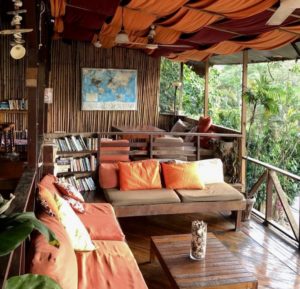 We spent the evening in the recommendable Hostel Plinio*, enjoyed the view of the sea on the horizon and took a short swim in the pool. The hotel is located just a few kilometers from the park entrance and has a typical hostel atmosphere.
We spent the evening in the recommendable Hostel Plinio*, enjoyed the view of the sea on the horizon and took a short swim in the pool. The hotel is located just a few kilometers from the park entrance and has a typical hostel atmosphere.
- great breakfast
- nice hostel atmosphere
- feels like a huge tree house
- amazing pool
Our Hostel Plinio close Manuel Antonio Park*
Day 8: Manuel Antonio National Park
On day 8 of our 3 week Costa Rica itinerary we finally visited the Manuel Antonio National Park. The park is very touristy, because pretty much every tourist in Costa Rica passes by here. But still the park is extremely worth seeing in our opinion. Because nowhere have we seen more animals so close in front of us on our Costa Rica itinerary.
In Manuel Antonio you also have the possibility to do a guided tour at night*. Here you get to see some other inhabitants of the parks and an insight into how a night in the jungle must feel.
Night Tour at Manuel Antonio | Check Prices*
You can find all information about our visit in our detailed travel report about Manuel Antonio National Park*.
After visiting the Manuel Antonio national park, we drove a little further or about n hour, to the village of Jaco, where we checked into the Buddha House Hostel*. The hostel was just on offer at Booking.com and is also highly recommended.
Our recommended Hotel Buddha House in Jaco*
Day 9: Samara on the Nicoya-Halbinsel
Shortly after our departure, we made a small stop on the Crocodile Bridge near Jaco. A wide, brown river runs under the bridge and is inhabited by giant crocodiles. To take a look at the crocodiles, you can simply park in front of or behind the bridge and then walk along the edge to about the middle of the bridge.
And there they were … 10 huge crocodiles laying on land and in the shallow water of the shore. One opened its huge mouth and showed us its scaring teeth. Otherwise … nothing happened. The animals were lying around motionless, so you could almost think they weren’t real.
After this little stopover we drove to our actual destination of day 9: Sámara on the Nicoya Peninsula. We had informed ourselves a lot beforehand whether we should go to Sámara or better to Tamarindo. Based on the positive reviews and ratings we read, we had chosen Sámara.
Sámara is described everywhere as a small, relaxed place with few tourists and a chilled vibe. Unfortunately, our perception was completely different. We didn’t feel comfortable here at all. However, this can also be due to the circumstances and how the day went for us.
Sámara was waiting for us with pouring rain, which shouldn’t affect our mood too much. However, after we parked our car on the roadside for a short exploration, the car suddenly did not start anymore. Something was wrong with the battery, apparently. Fortunately, a few friendly locals helped with the pushing, so that the car started again briefly and we were able to drive to the Alamo station in town, which was only 200 meters away.
Since it quickly became clear that we had to have the battery replaced, we rented a small hostel (Hostal El Dorado), which actually had very good reviews on Booking.com. Although the owners were very friendly, the hostel was pretty musty and shabby. We felt so uncomfortable that it was clear to us that we would leave the place as early as possible the next day and also leave Samara.
Day 10 + 11: Tamarindo
Before we went to Tamarindo on our Costa Rica 3 week itinerary, we wanted to explore some of the surrounding beaches. After we had been in Costa Rica for a few days without really spending time on the beach and swimming, we chose Playa Flamingo near Tamarindo for our first day on the beach. Even though it was still cloudy, we were able to enjoy the cool water at Playa Flamingo for the first time and jump happily through the waves. We were fooling around in the water like children and the tension of the previous day finally fell away from us.
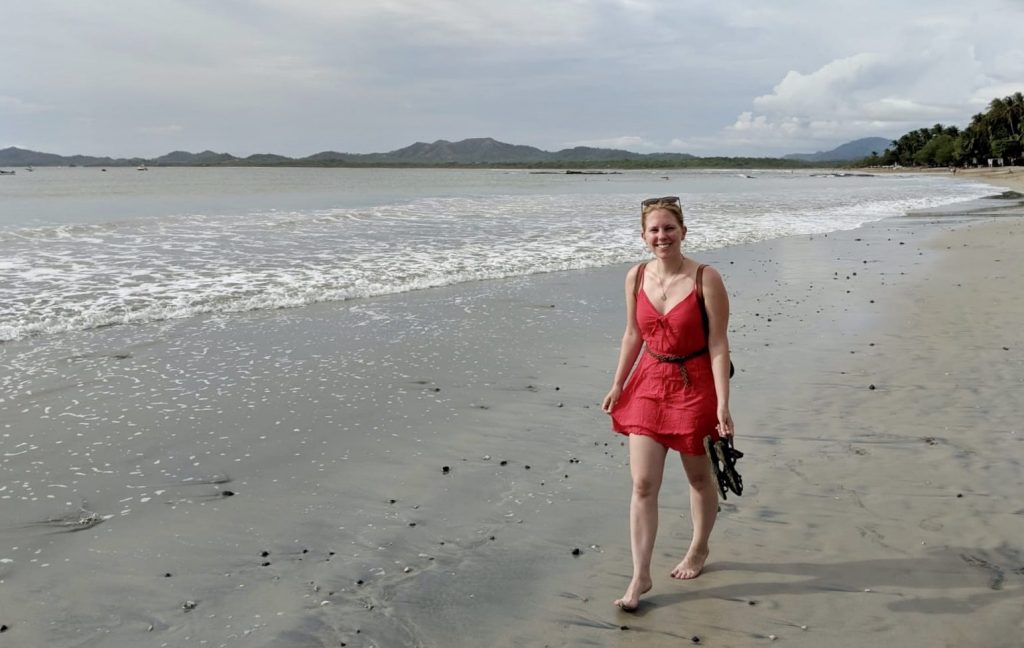
Also, after the somewhat musty hostel in Samara, we decided in Tamarindo for a more chic accommodation. A cozy, small apartment in the Hotel Gardenia Tamarindo was waiting for us. We would definitely feel comfortable here for the next two days. After we settled in at the hotel we went to the local Playa Tamarindo.
Hotel Recommendation in Tamarindo
There are several apartments at Hotel Gardenia* in Tamarindo, built around a pool. It is only a few minutes drive to the center and also to the sea. The apartments are quite large and all have their own kitchen. Everything is nicely equipped and you can feel really comfortable here. We just had an amazing time here.
Our Luxurious Apartment with Pool in Tamarindo*Playa Tamarindo is an elongated, wide beach that is known as a good surfing spot. The beach of Playa Tamarindo ends on a river in the north. Playa Grande begins on the other side of the river. The river itself can be crossed by water taxi for little money.
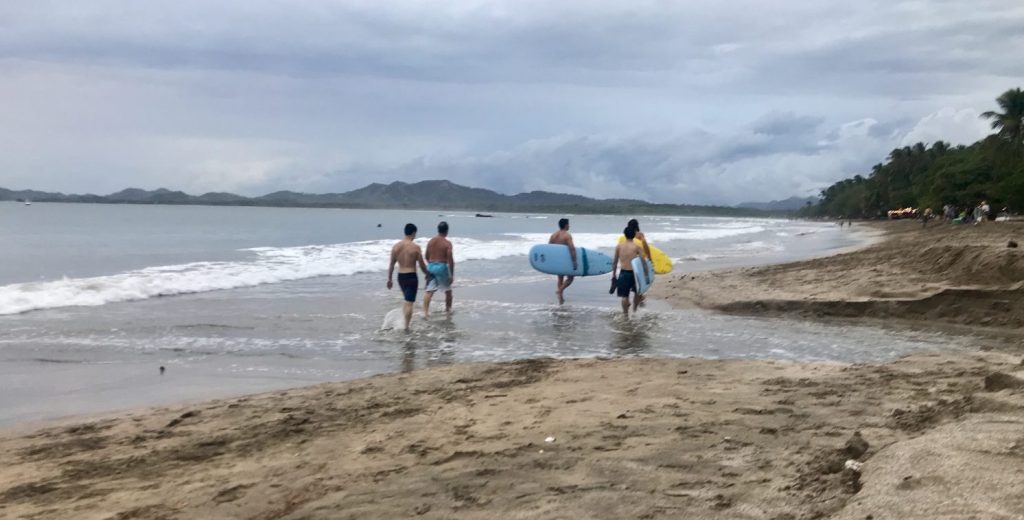
At Playa Tamarindo, there is the very busy area with many surfers, restaurants, etc. on the right-hand side. But it is much quieter on the left-hand side. There are only a few surf schools here. We chose the quiet side when we first visited the beach and wanted to visit the viewpoint beach at the end of the beach.
Black Sand Beach 
To get to the black sand beach, follow the signs and the small footpath at the end of the beach. The path goes up a small hill on the left. Then you arrive on a small fork where you can either go to the small viewpoint or down to the beach. At the end there was a small stretch of beach with completely black lava sand. We were blown away by it. We both had never seen a really black beach before.
Fortunately, we had the camera with us and were able to take a few photos on this cool spot. From here it went on to the viewpoint. At this point, the waves clap against the rocks with full force and the white foaming spray spurted up. The beach walk was a nice and relaxed introduction to our time in Tamarindo.
A special highlight which we would like to recommend to you in Tamarindo is a sunset sailing tour*. On the catamaran tour you will stop again and again to snorkel and in the evening you can watch the wonderful sunset from the sea.
Dreamy Sunset Cruise | Check Availability*
Tamarindo Night Market
However, there was another highlight for the evening. A small night market is held in Tamarindo every Thursday from 6 pm to 9 pm. Small stalls lit with lights offer local delicacies and handmade jewelry, art and cosmetics. There is also live music and a dancer performed during our visit.
The smell of all the delicacies on offer, the sound of the music and the many pleasant people let the relaxed vibe pass directly onto you and put a smile on our faces. The visit was a perfect end to the first day in Tamarindo. Here we had finally found the relaxed atmosphere that we hoped for from Samara.
The next day we finally wanted to fulfill our dream of surfing. We had been waiting for months after having to cancel our surf lessons on our last vacation in Indonesia due to illness. The day before we had already clarified the prices for the surf lessons ($ 30 pp in the off-season) … but as always it turns out differently than you think. I had a few nasty mosquito bites on my feet that were getting worse and worse. Everything was pretty red and swollen and the itching was driving me crazy.
The first postponement to lunchtime turned into a complete cancellation. Instead, I went to the pharmacy to get an ointment that was supposed to finally remedy the situation (which of course did not help). So two days later I went to the doctor, where I got a good dose of antibiotics, which finally made it better). In the end we spent the day with delicious food and Netflix while I tried not to scratch my feet too much.
Day 12 + 13: Monteverde
Since the weather in Tamarindo was rather gray and rainy, we continued to Monteverde on day 12 of our road trip through Costa Rica. Monteverde is settled in the cloud forest in the central region of Costa Rica. The cloud forest should be a very special experience during our road trip and should differ from the previously visited rainforests of Costa Rica. You can also find the famous, colorful Quetzal here, although I classified our chance of seeing it as rather low. The journey from Tamarindo led us about 160 km over sometimes more and less well developed roads in the mountainous northwest of Costa Rica.
Monteverde is almost 1500 meters high. Our small Suzuki SUV screwed up the switchbacks at a walking pace. Unfortunately, there was no great view. Because, as the name cloud forest suggests, exactly that was waiting for us … lots of clouds and fog.
We could see only a few meters through the impenetrable, gray fog. Even if this was part of the typical weather, I wondered how we should spot any animals in the forests. But since we didn’t want to go to the park until the next day, this wasn’t a problem.
In addition to the fog, the climate was also very different than before on the Pacific coast. When we arrived in Monteverde in our short clothes, we were actually cold. Quite a strange feeling on our trip. Also for the first time in weeks we had thick blankets in our hotel room (Montefresco Hotel Boutique* – the large room with terrace is highly recommended). In the afternoon we relaxed on our terrace with a view over the roofs of the small village and planned our activity for the next day.
Hotel Recommendation in Monteverde
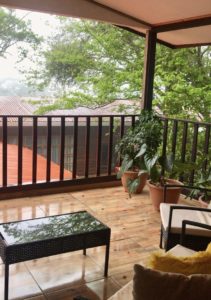 Montefresco Boutique Hotel in Monteverde
Montefresco Boutique Hotel in Monteverde
For a small extra charge, we were able to move into the penthouse room in the Montefresco Hotel, which is really very large, has its own bathroom and even its own,
terrace with a great view. We really felt very comfortable there. In the morning there was always a delicious breakfast and in the evening we could cook ourselves something to eat in the large communal kitchen.
- large communal kitchen
- Close to the cloud forests
- very nice staff
Even if, like us, you are not planning to take one of the many expensive ziplining tours (for which Monteverde is famous), you still have to choose between the two parks La Reserva Bosque Nuboso Santa Elena and the biological reserve Monteverde.
Biological Reservat Monteverde or Santa Elena?
Everyone always talks about Monteverde. Usually this means the region around the cloud forests. In this region you can visit two parks in the same nature reserve. The nature is the same in both parks. Nevertheless, there are a few subtle differences that we want to briefly list.
Monteverde:
- 13 km of hiking trails
- A free suspension bridge
- Very touristy
- Bus from Banco Nacional for $ 2, 4x a day
- Open 7 a.m. – 4 p.m.
- Admission: $ 22 p
Santa Elena Infos:
- 12 km of hiking trails
- a lookout tower
- Hardly touristy
- Bus from Banco Nacional for $ 2, 4x a day
- Open 7 a.m. – 4 p.m.
- Admission: $ 16 pp
At first I was a little skeptical whether the cloud forest really differs so much from the previous parks. But yes, it really differs. The trees and plants are all covered by a rich layer of moss and ferns. Everything is greener and the forest appears even thicker. In addition, there are the wafts of mist that pull through the tree tops again and again and give it a magical atmosphere. I almost felt like I was in a magical fairytale forest as we strolled along the hiking trails.
We hardly met any other people on the paths. And the one time we met them, they stared spellbound at a tree. There he sat … with his iridescent green plumage, red chest and long white tail feathers. The Quetzal. I could hardly believe my eyes that we were so lucky and that he was sitting on a branch a few meters away from us. We were still amazed at this wonderful creature while the next moment it spread its wings and disappeared into the air.
So we had already experienced the highlight of the hike at the beginning. On the further paths we were accompanied by a horde of monkeys high up in the trees, while the centipedes crossed our paths again and again on the ground.
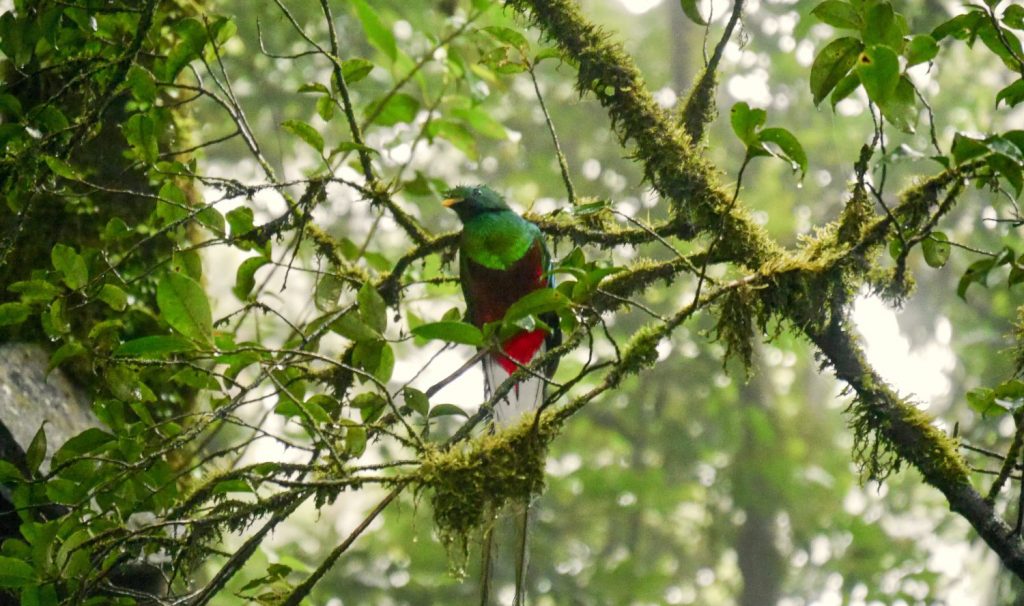
Action Sports in Monteverde
In addition, you can do a lot of action sports here. In particular, there are numerous opportunities to go ziplining*. Thereby one races on long wire ropes through the nature. For us, this was too expensive at just under $50, and besides, we had already done something like this in Croatia. But if you also like action-packed leisure activities, then this is definitely the right place for you.
Ziplining in Monteverde | Check Prices*
Secret Tip: The Ficus Tree in Monteverde
After visiting the Santa Elena National Park, we made it to another highlight of the Monteverde region. A ficus tree, through which you can climb. You heard correctly: You are not climbing up the tree, but through the inside of the tree. This is possible due to the special shape of the building trunk. The tree looks like a climbing opportunity in an adventure park. But it is real and completely natural.
At the bottom the tree is still quite wide and it is easy to get inside. The tree trunk is hollow on the inside and it looks like it is surrounded by huge, wooden creepers. It’s also pretty easy to climb up. It’s like a big climbing frame. At a height of around 50 meters, it is of course quite narrow. You only pass through there alone. If you are agile enough, you can stick your head out of the top of the building and look at the area. For every adventurous person (like me) an incredible experience and definitely a must-do in Monteverde!
How to get to the ficus tree?
To get there you can simply park on the side of the road (note: take your valuables with you!). From the street you have to walk about 100 meters through the forest. You can find the parking spot here on Google Maps. When you have parked your car on the road, you can take any of the visible trails into the forest. All lead down to the ficus tree.
Current info January 2022: We have heard from other travelers that the Ficus Tree is currently no longer accessible. It is probably now on private property and is secured with a fence and cameras. We think this is a real pity!
If you want to spend more days in the region and therefore still have time and above all money, there are many other activities in the region that you can do. Most of them are quite expensive, which is why we didn’t do them. We have put together a small selection of possible activities in the Monteverde region below.
Activities in Monteverde:
- Monteverde Butterfly Garden
- Night Walk*
- Serpentarium
- Ziplining*
- Coffee Tour*
- Chocolate Tour
- Waterfalls, Wild Trekking, Horse Back Riding*
Day 14 + 15: La Fortuna
The rain of the past few days should also accompany us on our Costa Rica road trip to La Fortuna. We had actually already planned a first hike for the day of arrival. But since we have been hiking in the rain for the past few days, we did not feel like another wet hike.
So we researched alternatives standing by the roadside and came across a wide range of spas and hot springs in the area. However, the prices were quite expensive. $ 40-50 per person, or even more, were called up for a day to the thermal baths.
Cheap Hot Springs in Fortuna
When we were about to resign with the day at the hostel, we came across the hot springs of the Hotel Los Lagos. Multiple pools and slides for just $ 17 per person. We didn’t have to think long about it.
Only 17 USD per person in Hot Springs in La Fortuna
Do you want to go to a hot springs in Fortuna for cheap money? Then go to the Hotel Los Lagos. You can find the Los Lagos on Google Maps.
Where?
You will not find any information online about this price or the day entry for USD 17. You just drive to the entrance, park your car and go to the reception. There you say that you want to go to the Hot Springs, pay the USD 17 per person and then get a small bracelet.
How?
When you have the bracelet, you drive through the entrance, park and can change in a separate building. A spin or a towel costs extra. So it’s best to take your own and leave your things in the car. Then the fun can begin.
What?
There are several slides and many (cold and hot) pools. In addition, whirlpools, sun loungers and everything is really tastefully and stylishly furnished. A really great facility.
If you are already on the premises, you can also look at the butterfly house, a crocodile (a bit sad in its way to small enclosure) and hummingbirds in the garden. It is definitely worth it.
Spending the afternoon in Los Lagos brought us back to childhood. Again and again we slid down the slides into cool or sometimes warm water. During the breaks from slipping, we relaxed in the hot whirlpools and let the water massage our backs.
Free Hot Springs in Fortuna
If spending $ 17 is too much for you, you can also use a free alternative. Next to the Tabacon Hot Springs, there are hot springs right in the river where you can take a pleasant bath. There are also some parking spaces on the street, as the free hot springs are also very popular with the locals. You can find the free hot springs in Fortuna here on Google Maps.
After a relaxing day in the hot springs, we hoped for at least dry weather for the next day and were lucky. Finally we could hike and see the volcano. The day before, the volcano had been hiding in the mist and clouds and never showing. Since it had cleared up a bit, the first view from the window of our hostel was directly to the Arenal volcano.
Arenal Volcano National Park
After a quick breakfast we went to the Arenal Volcano National Park. At the main entrance we could buy the ticket for $ 10 per person and then drive to the parking lot. The national park also includes a second trail that gives you a view of the lake and is about 2 kilometers away, which you can cover by car after the first hike.
Trail #1
The first trail is a circular route that partly leads over old lava fields and has various viewpoints on the volcano. We found the hike to be rather modest. The path is not particularly varied and we also imagined the lava fields to be really exciting. However, what really impressed us was an approx. 400 year old giant tree. The huge roots pave the way up to the trunk, which is several meters wide. Wow … the sight made us really silent. Next to the volcano itself, this old tree was the most fantastic sight in Fortuna.
The second part of the Arenal national park
From here we went back to the parking lot and by car to the second hiking trail on Lake Arenal. The hiking trail on the lake is well developed (asphalted) and offers several viewpoints and a high observation tower. However, we liked the coati much better than the lake, digging a hole on the side of the road in all serenity and not being distracted by us.
We also liked the part of the national park on Lake Arenal better than the part on the volcano. However, we found that you can also skip the national park completely if you don’t have enough time or money.
Hotel Recommendation in La Fortunga
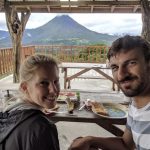
During our two nights in La Fortuna we stayed in the Eco Torre Lodge. From the rather simple rooms and wooden huts you have a magnificent view of the volcano.
The beautiful large terrace and the small, sweet dog of the owners also contributed to our great stay.
Eco Torre Lodge with a perfect view on the volcano*
Day 16: San José
After 10 days of a Costa Rica road trip, we had to say goodbye to our small SUV and headed back to San José. Since our next destination should be Tortuguero and you should start your journey by bus in San José one day in the morning, we decided to stay at the Hotel Kekoldi (a bit noisy, but nice rooms with a great breakfast).
On the next morning we went to the bus station within walking distance to get to Tortuguero. How exactely we got to Tortuguero you will find out in the article of the next day.
Our Hotel Recommendation: The centrally located Hotel Kekoldi in San Jose*
Day 17-19: Tortuguero
On the seventeenth day of our Costa Rica 3 week itinerary, we finally went to the turtle hotspot of Costa Rica, the Tortuguero National Park, on the Caribbean coast. But should you visit the turtle paradise in Costa Rica in the off-season? We were in Costa Rica in May / June 2019 and were considering whether to take the long journey, even if we would not see any egg-laying turtles outside the turtle season.
Tortuguero National Park covers about 20,000 hectares, was founded in 1975 and is located in the northeast of Costa Rica on the Caribbean coast. Its landscape, surrounded by dense rainforest and its location by the sea make this place truly unique and beautiful. There is a diversity of plants and animals here that can be found in few other spots in Costa Rica.
About half of Costa Rica’s bird and reptile species live here. Sloths, iguanas, caimans, toucans, parrots, many species of monkeys, crocodiles, manatees and over 300 species of birds can be found here. The location between the Caribbean Sea and the Rio Suerte jungle river makes this spot a very special place. Here you can sunbathe on the beach and swim in the ocean in the afternoon and then walk a few meters over to the river side to watch the sun set behind the Rio Suerte.
The best thing to do here is to take a tour with a guide* who can tell you a lot about the plants and animals of the national park.
Explore the Wildlife at Tortuguero*
In this travel report you can find out why it is worthwhile to go to this secluded sandbar on the Caribbean coast in the off-season without turtles: Tortuguero – What to expect in the low season
Accommodation in Tortuguero
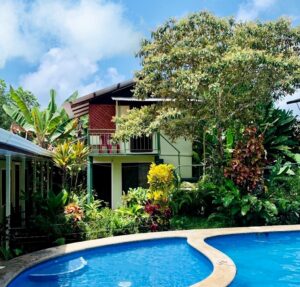 By the way, we spent the night in Tortuguero at Hotel La Casona, which is a simple but still very cozy hostel near the beach.
By the way, we spent the night in Tortuguero at Hotel La Casona, which is a simple but still very cozy hostel near the beach.
- nice pool to relax
- cozy rooms
- shared kitchen
- close to the beach
Day 20: San José
We had actually finally said goodbye to San José and didn’t want to go back to the lively capital. However, since Andreas had problems with his Mavic Air drone, we had to travel to the big city again to use the iCon DJi repair service. Thank God that went very quickly.
In order to have a relaxing evening after the repair, we decided this time for the Fauna Luxury Hostel*. The rooms are beautiful and spacious, with a pool, table tennis, billiards and a good breakfast. The cheap hostel was once a luxury hotel (hence the name) and now offers multi-bed rooms and cheap double rooms.
Our Cheap (former) Luxury Hotel in San Jose*Day 21-24: Puerto Viejo | Last Days of our Costa Rica 3 Week Itinerary
After a short detour to San José, we quickly went back to the Caribbean coast on our Costa Rica itinerary. This time, however, further south to Puerto Viejo. From San José, a bus runs from Terminal Atlantico Norte directly to Puerto Viejo within approx. 4.5 hours (for 6,060 Colones pp, approx. EUR 9.30).
Puerto Viejo welcomed us with blue skies, sunshine, white beaches and a relaxed attitude to life. We would definitely spend a few days here. After all, there is also a lot to see here. There are two national parks nearby, the Cahuita National Park and the Manzanillo National Park. Although we were in Puerto Viejo for a total of 5 days, we were unable to visit one of the parks. We were too infected by the relaxed atmosphere and doing nothing. However, we were not completely inactive.
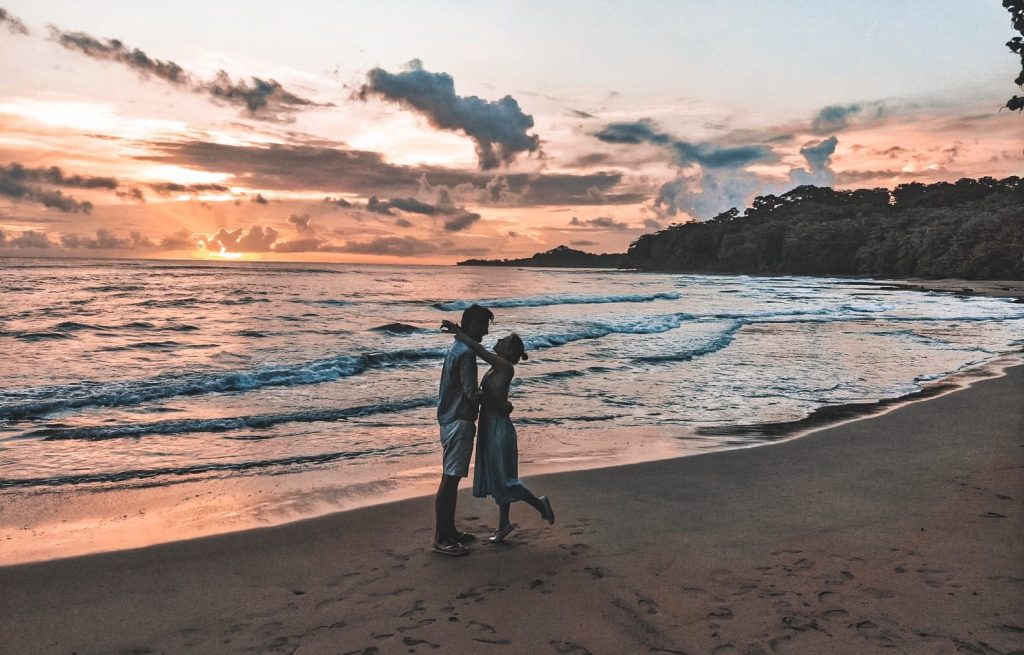
So we spent the first afternoon on the beach and jumping through the waves in the sea and watching the red sun slowly set behind the palm trees.
Hotel Recommendation in Puerto Viejo
For the last stop of your Costa Rica backpacking trip we recommend a really great and cozy accommodation. For the last few days you can treat yourself and choose a chic accommodation with a great pool and right on the beach.
Le Cameleon Boutique Hotel* is beautifully located in the green and offers you everything for a few relaxing days in Puerto Viejo. The beach area is simply beautiful and you will also see sloths in the trees from time to time.
The Amazing Cameleon Boutique Hotel in Puerto Viejo*Snorkeling in Punta Uva
On the second day in Puerto Viejo we wanted to go snorkeling for the first time on our trip. I had previously read that Punta Uva is good for snorkeling. In order to reach the beach a few kilometers away, we rented two bicycles near our accommodation (6,000 colones for 24 hours, around 9.00 Euro). The beach is really beautifully situated in a bay lined with palm trees. But we couldn’t snorkel there that day. The sea was very churned and you saw absolutely nothing in the water. So we were “only” swimming in the wonderfully cool sea.
First Time Surfing
Since we had no luck snorkeling the day before, at least we wanted to realize our dream of surfing in Costa Rica. So the next day we went to Playa Cocles, which also has suitable sections of beach for beginners. As it was our very first time, we booked 2 hours of surf lessons with a surf instructor directly at a beach stand ($ 40 per person including surfboards for 2 surf lessons plus 2 more hours of surfboard rental for practicing on the same or next day).
After an approx. 20-minute introduction on the beach, during which we got some safety instructions and went through the first exercises for getting up, we went into the water. It was my turn first and at least I stood on the board for a little moment. Then it started for Andreas and he mastered the first attempt perfectly. This is where the experience of snowboarding becomes apparent.
Practicing
And so we diligently practiced 2 hours with the surf instructor in the water. Again and again we struggled with the boards against the current that tugged at our feet to try again. From time to time it got better. And from time to time the strength decreased. After 2 hours we were totally broken, but also totally happy and flashed.
We definitely wanted to do that again!
Actually we wanted to surf again the next day (redeem our free 2 additional hours). However, we were the only ones on the beach. After it poured all day, we went to the beach in the early afternoon to deepen our newfound passion for surfing. But not a single surf rental was open, so we spent the day on our bikes and on the surrounding beaches.
Renting a Bike in Puerto Viejo
Bicycles are really one of the top ways of transportation in the small Caribbean town. You can rent a well-maintained bike anywhere and ride it for just under $ 5. Since our hotel was less than 6 kilometers away from the city center, it was a bit to drive, but with the cooling wind in the face and the palms hurtling past it was a great experience. It was only 2 kilometers from our accommodation to the “snorkel” beach Punta Eva, which we covered in a few minutes.
We also saw some surfers who carried their surfboards in a special device on the bike. Bicycles are not as much part of the cityscape as maybe in Amsterdam, but a lot of tourists grab one and make the Caribbean coast unsafe.
By the way, service is also part of many providers. When Andreas stopped several kilometers from the rental station with a flat tire, I drove up alone to inform the guy from the rental station. He then drove to Andreas with a spare wheel and changed the flat wheel so that he could continue to drive. Great service!
Day 25: Leave for Panama – Bocas del Toro
After three weeks in Costa Rica we said goodbye to this beautiful country to immerse ourselves in the relaxed island life on the Bocas del Toro for a few days. The Bocas del Toro are a small group of islands in the Caribbean Sea off the coast of Panama and right on the border from Costa Rica. They are therefore a popular destination for Costa Rica travelers and are also very easy to reach from. How exactly you get there and what are the things to do, we have summarized in the next travel report.
★ How to get from Puerto Viejo to Bocas del Toro, Panama ★Do you also plan to spend three weeks in Costa Rica and still have some questions about your Costa Rica travel route? Or do you want to tell us about your own experiences? We would appreciate a comment in our travel report.



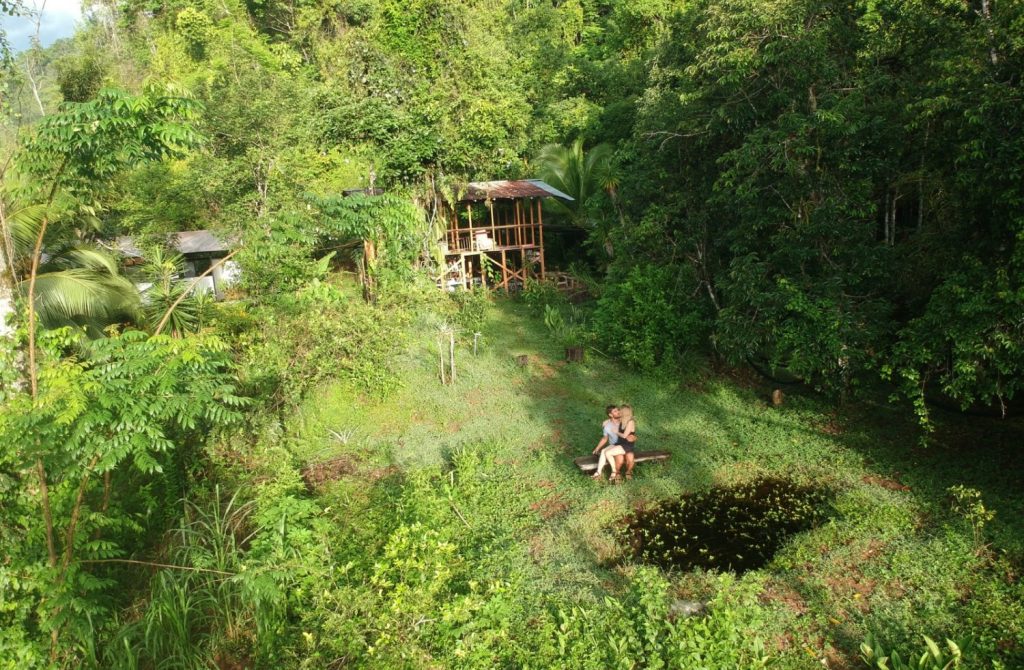






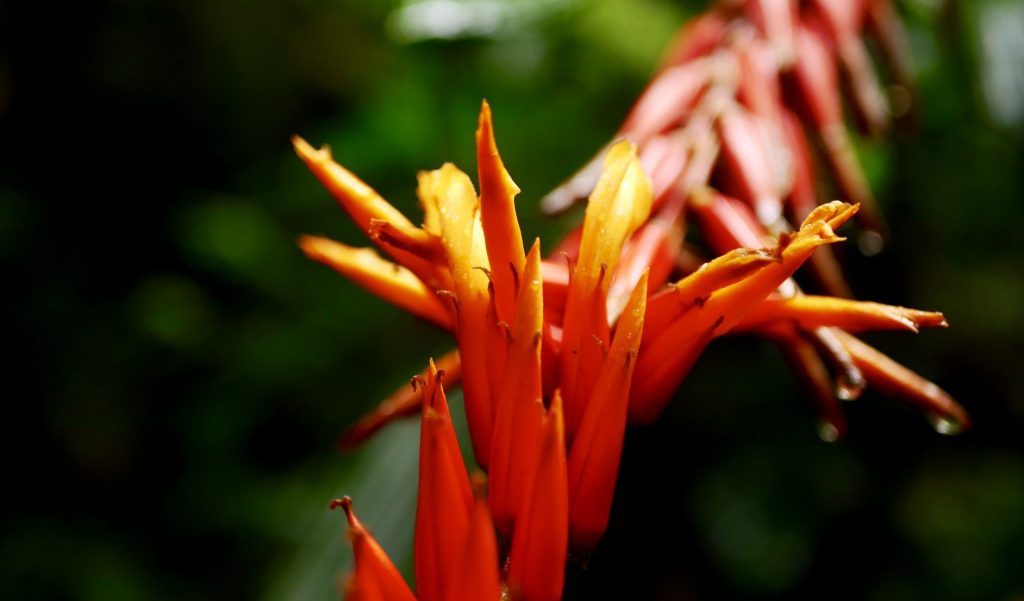












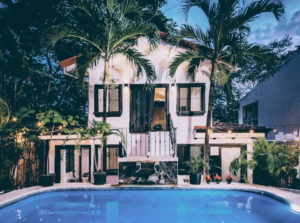
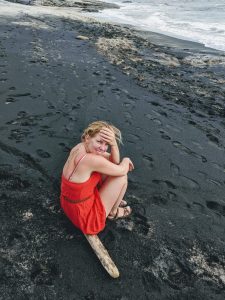


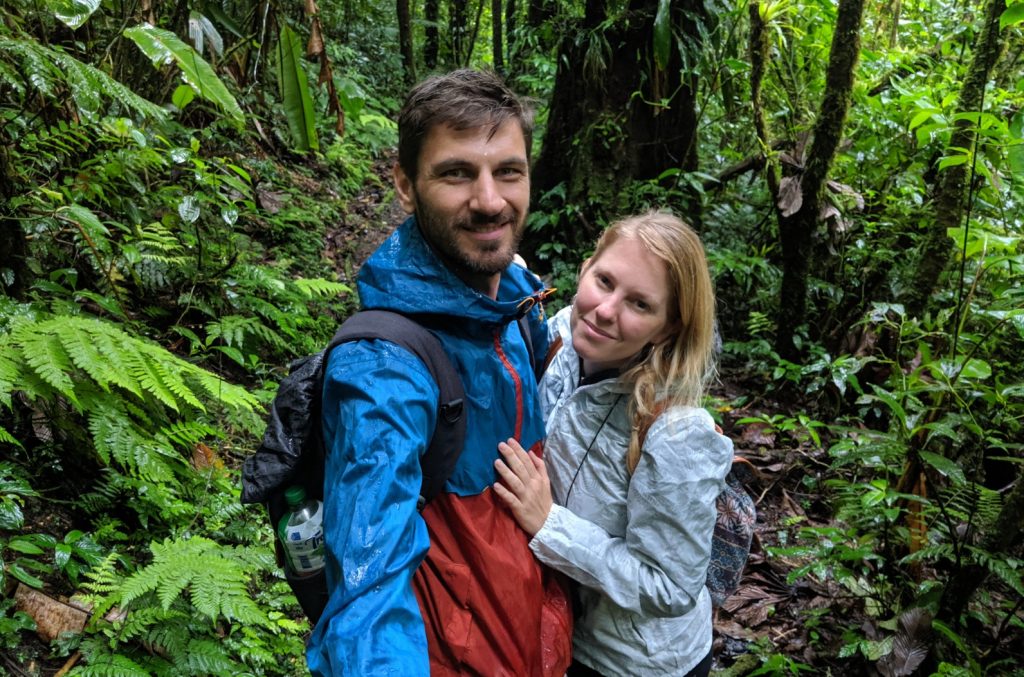



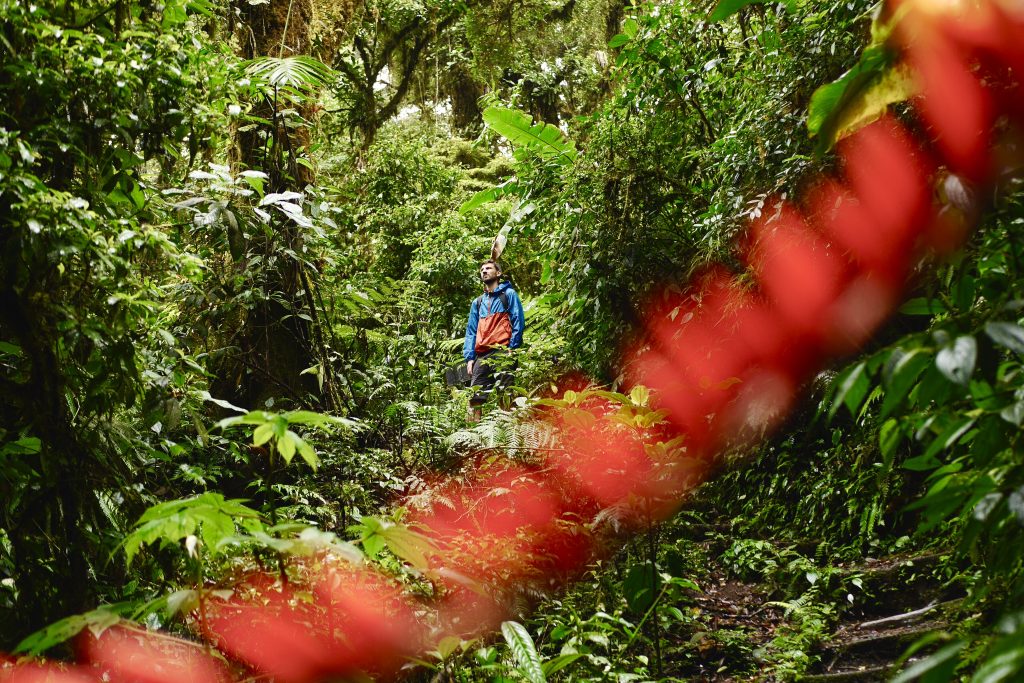





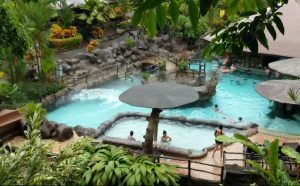
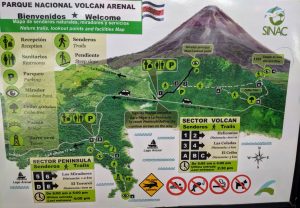
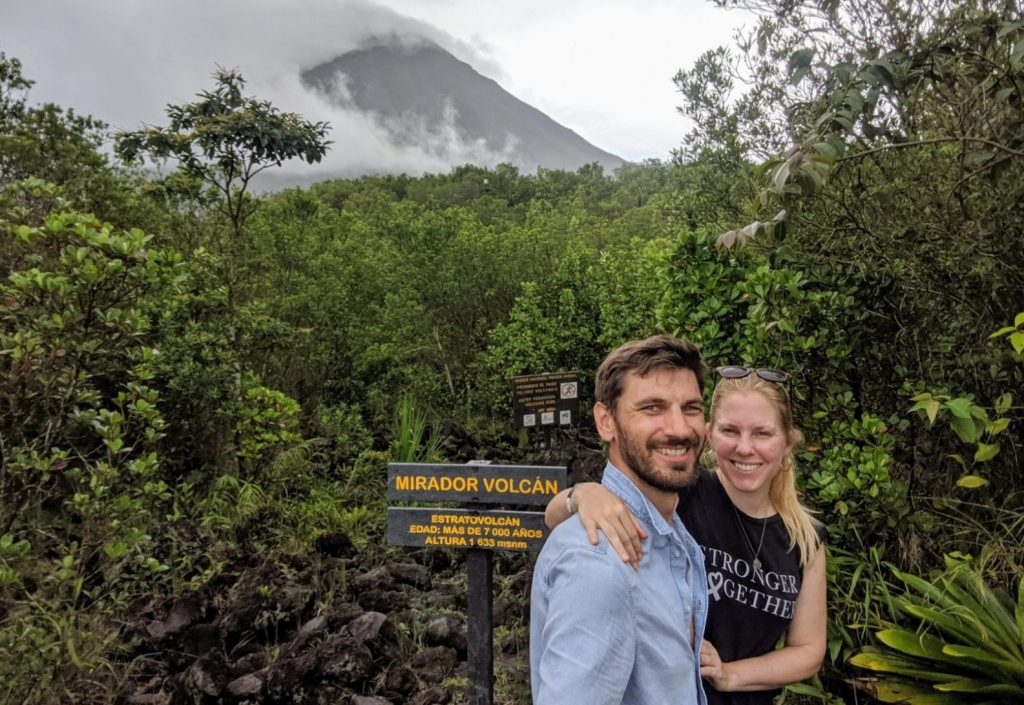
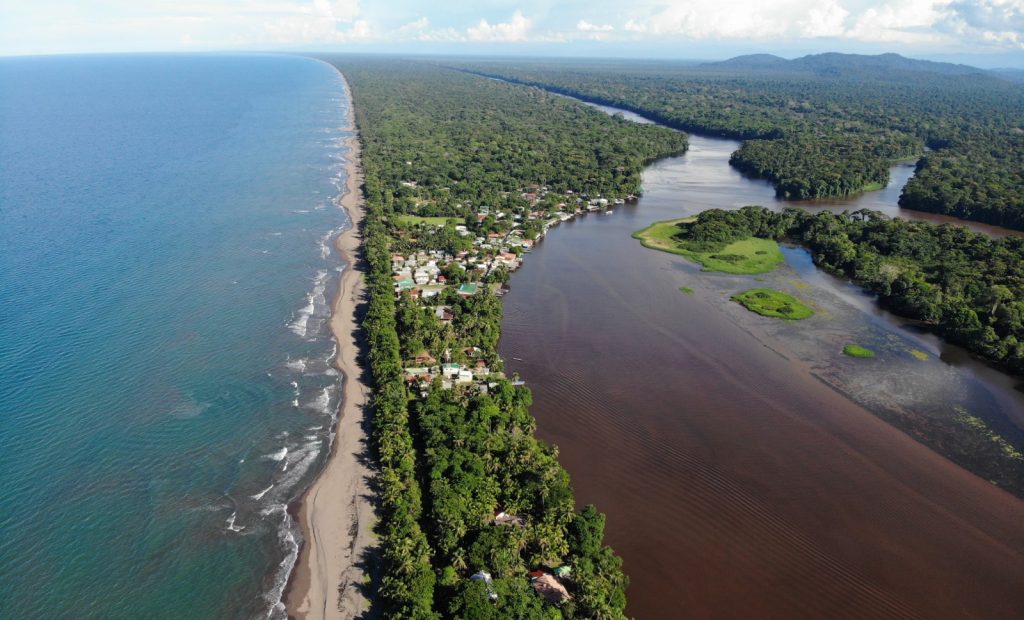



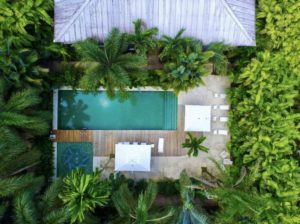


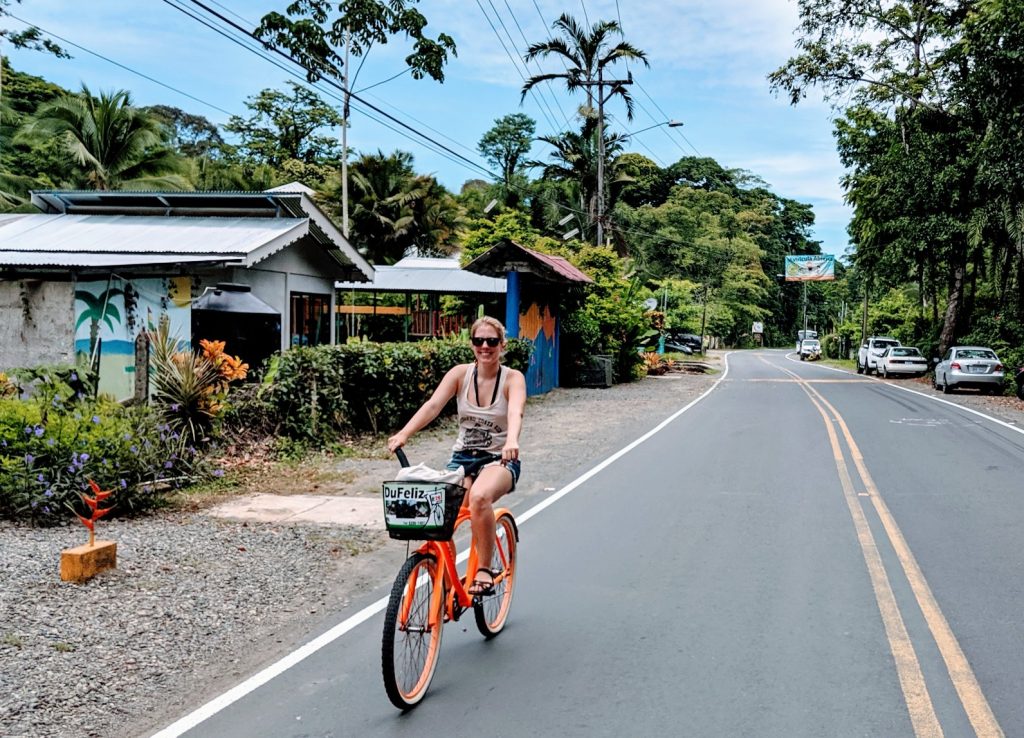
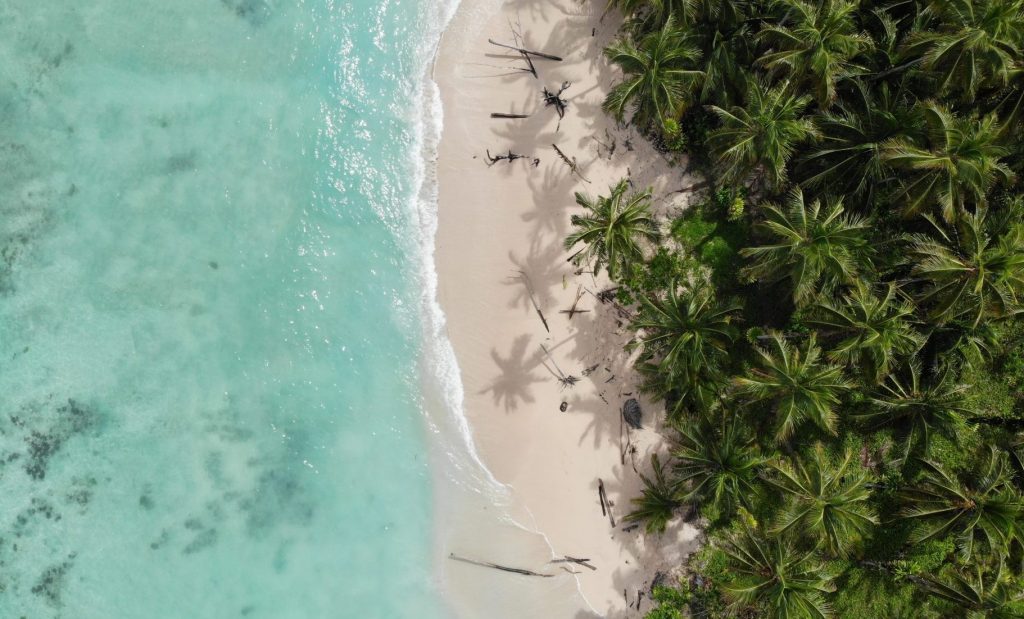



This is the most in-depth guide I have read about Costa Rica to help me prepare for my trip next year. Super helpful – thank you Sabrina & Andreas x
Thank you very much, Sandra XOX